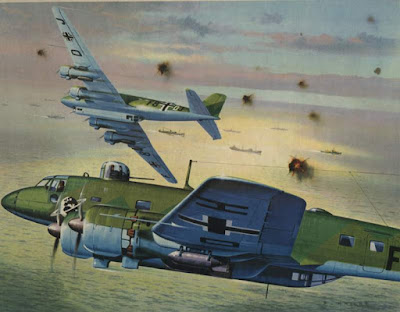While the Second World War resembled the First in that the
largest operations of all were waged on one continent, Europe, it also
resembled its predecessor in that much of the struggle took place at sea. Until
the spring of 1943, submarine warfare probably represented the one method by
which Germany could have beaten Britain and forced it to surrender. Conversely,
first Britain’s survival and later its ability and that of its larger and more
powerful American ally to bring forces to bear against Germany (and Italy)
depended on their command of the sea-lanes. Though the Mediterranean was never
more than a side theater, here, too, ultimately it was command of the sea that
decided the issue. The difference between the two world wars was that, from
1918 to 1939, military aviation developed far more rapidly than warships and
merchantmen did. By the time World War II broke out, there was still much
argument about how much air support navies required, how it should be
organized, and what tasks it should carry out, but the principle that they
could not operate without such support had been firmly established.
Having already said something about the Mediterranean, and
leaving the Pacific until later, here we shall focus on the Atlantic. In
1939–45, as in 1914–18, without the sea-lanes across the Atlantic, Britain
could not exist and would have to surrender sooner rather than later. As in
1914–18, what decided the issue was not so much a Mahan-like encounter between
opposing fleets as a long struggle of attrition. That struggle was waged mainly
by light naval units and the aircraft that worked with them. As in 1914–18, one
of the first things the British did was to revert to the convoy system and to
blockade Germany. The Germans on their part used their submarine fleet to
impose a counter-blockade.
Seen from the viewpoint of airpower, the struggle was not
symmetrical. Wherever they went, the British could and did use aircraft,
whether land-launched or carrier-borne, to hunt for German submarines as well as
the few other blockade runners, armed and unarmed, that got through. Whatever
may be said about relations between the navy and the RAF, cooperation between
it and Coastal Command was always exemplary. Meanwhile the German Navy, the
Kriegsmarine, owing partly to geography—Britain still stood between it and the
open ocean—and partly to its peculiar relationship with the Luftwaffe, did not
have nearly as much support from the air. Lacking it, the Naval War Command,
the Seekriegsleitung, in Kiel had to rely mainly on RDF (radio direction
finding), ELINT, and SIGINT to receive warning that Allied convoys were setting
sail, on what course, with what destination, and so on. The ability of
submarine captains to locate their prey was greatly, perhaps fatally, reduced.
They were forced to spend more time on the surface, where they were vulnerable
both to surface ships and to aircraft; coming under attack by the latter, all
they could do was either submerge or fire a few shots from the guns some of
them started carrying from 1943 on.
From the Allied point of view, the worst moments in the
anti-submarine struggle were the first half of 1942 and the first half of 1943.
The worst month of all was June 1942, when 700,000 tons of merchant shipping
were lost. During both periods, airpower played a critical role in defeating
the menace. Based in Scotland, Ulster, Iceland, Greenland, and along the North
American coast from Newfoundland to the south, aircraft protected convoys and
searched for submarines. Either they attacked those submarines on their own,
dropping depth charges on them, or else they acted as the eyes of hunter-killer
groups made up of destroyers and other light naval vessels. The more time
passed, the more technological progress and the introduction of more long-range
aircraft limited the ocean spaces where submarines could operate in relative
safety. Some historians claim that this factor was the most important reason
why the Allies eventually came out on top. As one German U-boat captain told his
commander in chief, successful attacks on convoys were only possible as long as
there were no Allied aircraft around.


No comments:
Post a Comment